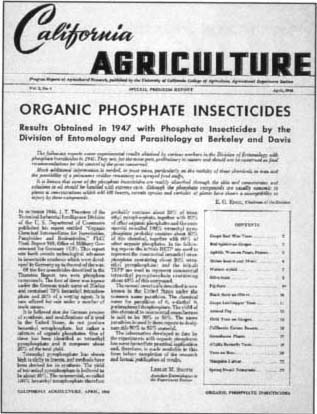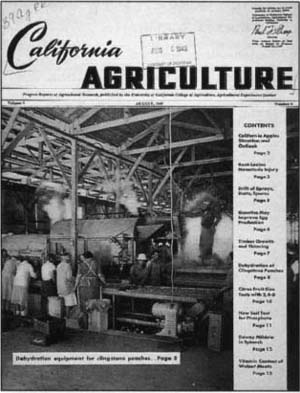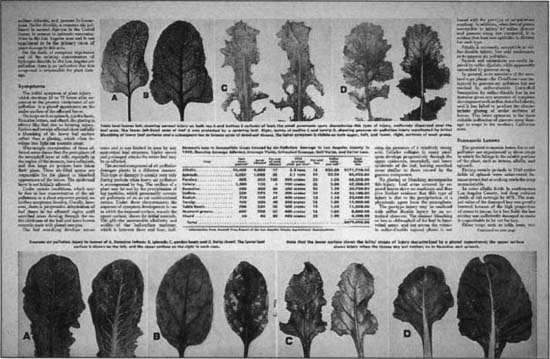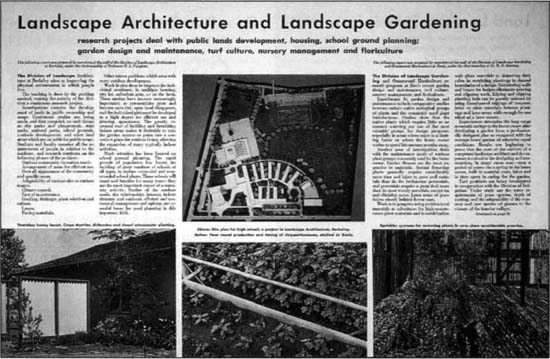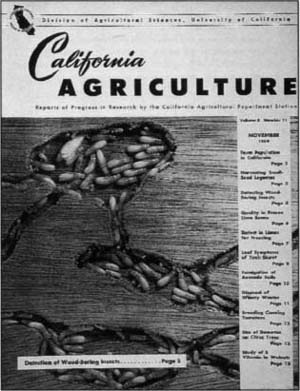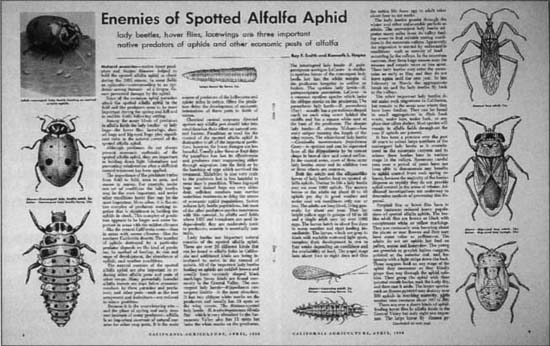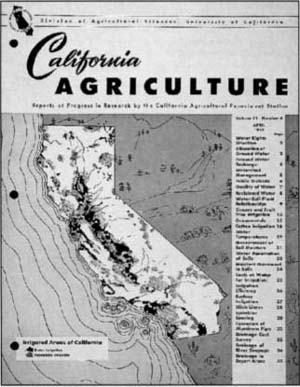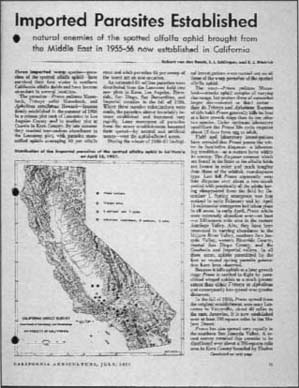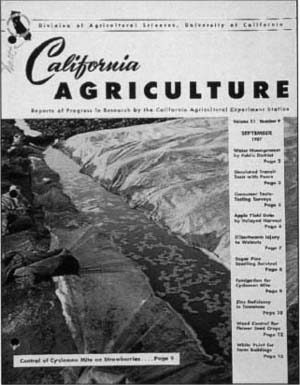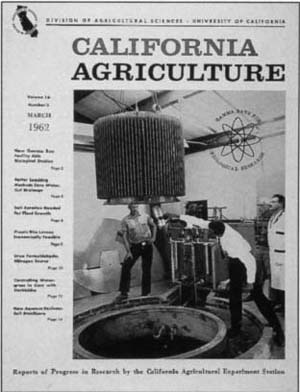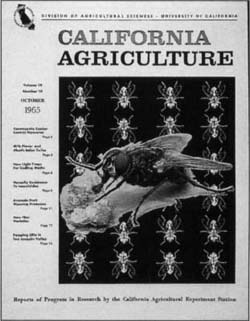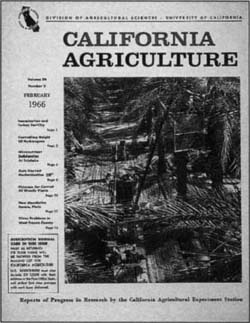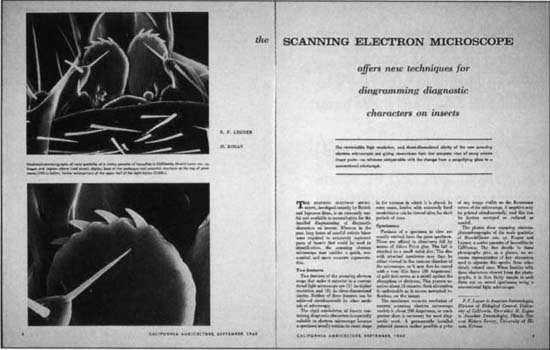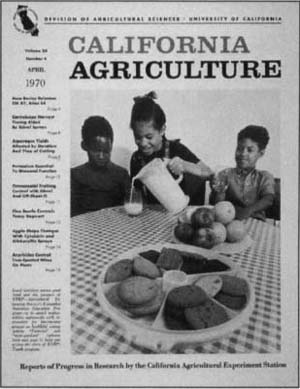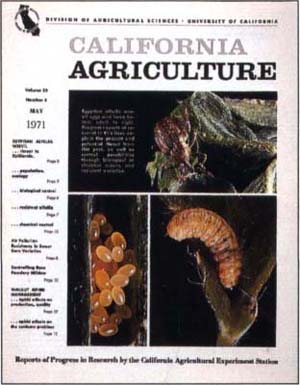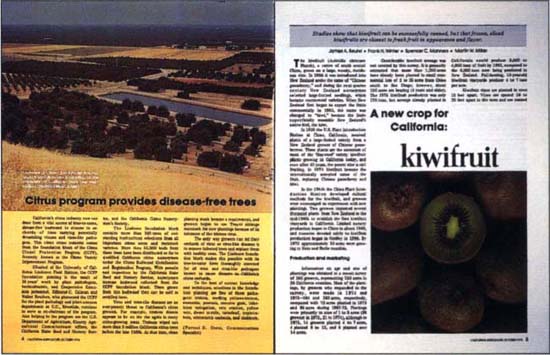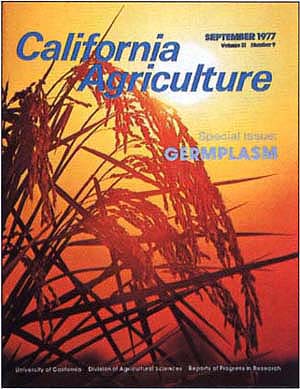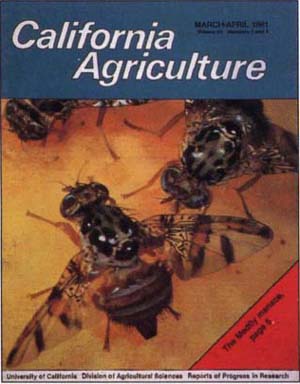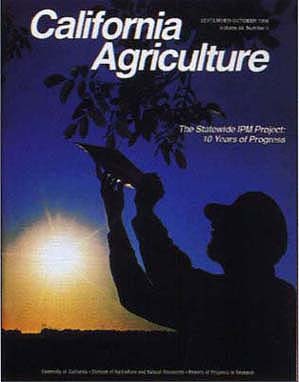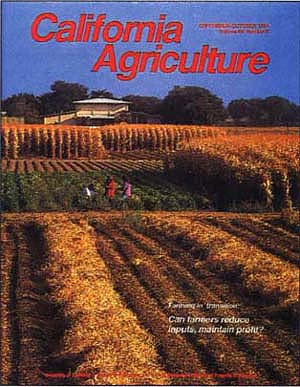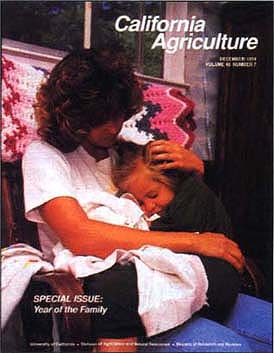All Issues
California Agriculture time line
Publication Information
California Agriculture 50(6):22-31.
Published November 01, 1996
PDF | Citation | Permissions
Full text
For five decades, California Agriculture has reported historical research developments and contributed scientific expertise to ongoing agricultural and environmental debates. In reviewing more than 300 issues of the magazine for this time line, the California Agriculture staff found many notable research contributions – advances in plant breeding, soil science, crop protection, environmental science, nutrition and other areas too numerous to list here.
This time line features historical events and concurrent research reported in California Agriculture. Historical events appear in Roman type, followed by material taken from California Agriculture in bold face. Historical sections are largely derived from Ann Foley Scheuring's Science and Service.
— Editor
1946–1955
The years from 1941 to 1973 have been termed “the second American agricultural revolution” by historians of science and technology. The factors that made up this revolution included greater use of soil conditioners, fertilizers and cover crops; adoption of more productive crop varieties and livestock breeds; more efficient crop production and livestock feeding regimes; widespread advances in mechanization; better control of insects and diseases; and more careful conservation practices. All were documented in California Agriculture.
The post–World War II era brought a new generation of insecticides such as DDT and the organophosphates. Developed during World War II to control insect-vectored illnesses, they appeared to offer both more effective pest control and less threatening side effects. Subsequent work led to the introduction of dozens of improved sprays or dusts and the dropping of older measures.
February 1947: “Control of Coddling Moth with DDT Spray on Apples and Pears Good in Investigational Work.”
April 1948: “Organic Phosphate Insecticides,” a special section of 17 reports, noted “Much additional information is needed … particularly on the toxicity of these chemicals to man and the possibility of a poisonous residue remaining on sprayed food stuffs.”
At the same time, other UC scientists were pioneering the new field of integrated pest management, first described in a 1949 article as “supervised control.”
May 1949: “Supervised Control of Insects” described the coordinated use of parasites, predators and chemical controls. The new method made it “possible to predict outbreaks of the alfalfa caterpillar three days to two weeks ahead of injury. These predictions make it possible to utilize cultural controls to their fullest extent and to time any necessary chemical control most effectively.”
The war years had forced farmers to function with less labor; widespread mechanization had begun.
January 1950: “Mechanized Agriculture” reported that “engineering applied to farm problems enables 15% of the population to feed the nation with surplus for export.” The authors continued, “One hundred years ago, 85% of the nation's total population was engaged in agriculture in order to feed themselves, as well as the other 15%. Today the figures are reversed….”
Major developments included the application and acceptance of the diesel engine to power farm tractors (rather than horses), the doubling of the number of California farms receiving electric current, the use of airplanes to seed, fertilize and spray crops, and the development of seed processing, planting, and harvesting equipment.
Around 1950, the growth of irrigated farming in the Central Valley and in the southern desert valleys watered by the Colorado River lifted California to first place among all states in value of agricultural products. Another result was the rapid depletion of the state's groundwater.
January 1950: “Groundwater Problems in California” reported this resource “in many parts of the state—is fast being depleted.” At that time one-third of farms received their entire water supply from groundwater and three-quarters of cities and towns drew part or all of their requirements from the same source.
The growth of farms and cities, with their increasing water needs, spurred construction of the Central Valley Water Project. In 1951, water engineers would begin pumping the first water directly south, almost 500 miles, from Shasta Dam to the San Joaquin Valley. In hot, dry Kern County at the southern end of the valley, cultivated land soared from 200,000 acres in the mid-1930s to more than 700,000 in 1960.
Population growth and its side effects became more evident in the 1950s. At the beginning of the decade, Los Angeles County was still one of the most agriculturally productive counties in the nation. By 1960 rapid suburban growth and accompanying air pollution had diminished the basin's productivity.
November 1950: In “Smog in the South Coastal Area” UC Riverside scientists reported the effects of air pollution on table beets, Romaine lettuce, Swiss chard, and spinach, noting the total cost of smog injury to Los Angeles County crops in 1949 was $480,000. Leaf damage by smog was first seen in 1944.
UC scientists would play multiple roles both in boosting farm productivity and in advancing the understanding of interactions between agriculture and the environment. While some studied pesticides' biological effects and developed recommendations for their use, others pioneered efforts in biological control.
November 1952: “Biological control of insects” reported, “California's subtropical climate favors establishment of natural enemies of agricultural insect pests.” Of 600 species of parasites and predators imported into the continental United States in the previous 60 years, 100 had become established, one-third of those in California.
In June 1952, the College of Agriculture was officially reorganized and renamed the Division of Agricultural Sciences under the direction of a new Vice President – Agricultural Sciences.
By 1955, research showing that synthetic pesticides could harm nontarget species began to appear in California Agriculture.
1956–1965
Scientists at UC led the nation in its growing awareness of the environmental effects of agriculture, including the sometimes negative effects of pesticide use. Even so, by 1956 more than 300 chemical compounds — fungicides, herbicides, insecticides, nematicides, growth regulators and more — were being used in U.S. agriculture, an estimated 20% of all usage in California.
February 1956: “DDT Residues on Sweet Corn” reported that DDT was applied to most of California's commercial sweet corn acreage. “While there were no measurable residues on the corn itself, there were high DDT residues on sweet corn forage, presenting a serious problem to dairymen because cows on a diet containing DDT secrete this substance in their milk and — according to both State and Federal law — no DDT is allowable in milk.”
The next year, partly because of public concern about pesticide residues in milk, the Legislature appropriated special funds for UC research on the health aspects of pesticide use. The Davis campus used its share to establish the Pesticide Residue Research Laboratory, the forerunner of the Department of Environmental Toxicology.
In 1956, the Regents approved organization of the Water Resources Center at UCLA.
April 1957: California Agriculture published its first special issue — 24 reports on the water problems facing agriculture, covering water rights for urban and rural users, groundwater allocation and recharge, watershed management, water quality, and practical and scientific aspects of irrigation. At that time, irrigated farming used more than 90% of California's developed water supply.
As urbanization progressed, UC programs reflected the changing demographics and problems of the state. In 1957, the Air Pollution Research Center opened at UC Riverside. In 1958 President Clark Kerr announced the reassignment of most of UCLA's agricultural program to the Riverside campus, and by 1965 the College of Agriculture at UCLA was phased out.
By 1960, farm residents accounted for only 2% of California's 15.7 million residents. Growing conflicts between urban and rural residents surrounded the competition for limited natural resources.
March 1959: “The Rural-Urban Fringe Problem” described bedroom boroughs growing in narrow strips along either side of major highways servicing the city. “The contour of the city becomes one of long arms reaching out in many directions to virtually surround unincorporated areas. While the city is organized to handle its internal affairs, it can do relatively little about many of the rural-urban problems thrust upon it.”
In 1959, the Burns-Porter Act authorized the State Water Project (SWP), narrowly approved by voters in 1960. Eventually the SWP provided water for the arid west side of the San Joaquin and the state's southlands.
By 1960, partly as a result of irrigation made possible by state water projects, the Central Valley's total agricultural production was valued at more than $3 billion— nearly 9% of total U.S. gross farm income, earned on about 3% of its crop land.
Through the end of the 1960s, University work focused almost exclusively on improvements in food production or advances in basic science.
February 1960: “Larger Strawberries Through Plant Breeding” reported two promising hybrids developed by crossing a South American strawberry with commercial California varieties.
By then, UC scientists had reported for several years on increasing insect resistance to insecticides, and on the effects of pesticides on nontarget species.
September 1960: “Effectiveness of Integrated Control Programs Against Pests on Agricultural Crops” listed problems resulting from widespread use of chemicals: “insect resistance to insecticides; rapid resurgence of the treated species, necessitating repeated applications; residues on crops; and secondary outbreaks of pests other than those against which control was originally directed.”
In 1962, California became the most populous state in the union and Rachel Carson's Silent Spring was published. Rachel Carson, an employee of U.S. Fish and Wildlife, drew some of her evidence from a 1956 monograph by UC Davis research zoologists Robert Rudd and Richard Genelly. Working on a grant from California Department of Fish and Game, they published a painstaking report on the effects of five major pesticides on California wildlife.
August 1958 through June 1977: For two decades California Agriculture frequently carried feature articles and cover photos of the newest farm machinery. During this period, 15 cover photos featured mechanical harvesters for different crops.
In 1965, the Johnson administration directed the Department of Labor to terminate the bracero program. Although braceros accounted for only about 30% of the total seasonal work force in California in the peak year 1959, they contributed more than 80% of the labor for the tomato harvest. With the end of the bracero program in sight, UC trials of a prototype tomato harvester had begun in several cooperating farmers' tomato fields. By 1970, California's entire crop was machine picked.
November 1959: “Harvesting Canning Tomatoes” described how wheelbarrows could be used to reduce the labor requirement for harvesting tomatoes “pending development of economic mechanized tomato harvesting.” The authors noted that a typical farm worker carried 2.8 tons of tomatoes a distance of 60 feet in a day, and hand labor constituted 88% of production cost.
June 1978: “Agricultural mechanization and public policy” assessed the social and legal implications of displacing farm workers.
The following year, California Rural Legal Assistance would file suit against UC alleging the University had used public tax funds to convey a private benefit to agribusiness. Eleven years later, the case would be laid to rest with substantive issues decided in the University's favor. However, the suit increased faculty awareness of the social consequences of research, and changed the University's behavior.
In 1965, the Mosquito Research Program was first funded. There was increasing recognition of shared urban-agricultural problems. There was also a growing awareness of new urban constituencies.
September 1965: In “California Land Conservation Act of 1965 … a new approach to problems of agricultural land use,” authors reported “the new law should help solve some of the serious problems of population growth and urbanization facing California.” The new law protected agricultural land, providing compensation to farmers of prime agricultural land if assessed valuations increased. They surrendered development rights for at least 10 years.
October 1965: Authors of “Housefly Resistance to Insecticides” observed “The housefly is the first insect species to have developed resistance to DDT. In California, this was observed in 1948 and was soon followed by resistance to lindane and dieldrin which were used as replacements for DDT.” Increasingly strict city and county ordinances had caused dairy farmers and poultry ranchers to make intensive use of insecticides.
1966–1975
In 1966, UC Davis reorganized to cope with changes in society since World War II. Chancellor James Meyer said “We should widen our horizons and think in international terms. The renewal and use of natural resources should be studied intensively…[and] should include the entire public interest.”
President Johnson established a National Advisory Commission on Rural Poverty charged with appraising conditions in substandard rural areas to develop a design for action programs. The commission's 1967 report, The People Left Behind, said “We have not yet adjusted to the fact that… from 1950 to 1965, new machines and new methods increased farm output in the U.S. by 46% and reduced farm employment by 45%.”
In 1969, Extension was required to accept the Expanded Food and Nutrition Education Program (EFNEP), which mandated outreach to nonfarm, nonrural clients in providing dietary counseling for low-income families.
April 1970: In “EFNEP-Youth … good food for good nutrition,” the cover photo showed “Mini-gardens planted in milk cartons [to] help EFNEP-Youth … understand the relationships between plant life, good food and good nutrition.” The article reported that over 15,000 California families were enrolled in EFNEP after the first year of operation.
By the 1970s, the Division's problems had often turned into issues — they involved complex, interrelated factors, many different disciplines, and, often, political processes not subject to technical manipulation. During this decade, the Division began to organize a new kind of problem-solving entity, the interdisciplinary task force.
September 1974: California Agriculture summarized major findings of A Hungry World: the Challenge to Agriculture — “a six-month study triggered by the worldwide food crisis of 1973.” This report projected the world food demand and supply by the year 1985. Among findings: “the projected shortfall of cereal grains in Asia, Latin America and Africa in 1985 is estimated at 11%, compared with 8% in 1970.”
The energy crisis of 1973 was a powerful cause for concern: “Energy shortages and resulting high prices for fossil fuels and fertilizer will have a particularly devastating effect on about 40 developing countries that have started moving away from nonmarket economies to intensive, efficient food production and marketing systems.”
In 1970, UC became the Sea Grant institution for California.
March 1970: “Mini-streams Aid Pollution Studies at U.C. Davis” reported that the impact of pollution on California's wild waterways was being studied in laboratories at Davis “with the help of miniature streams flowing in metal and plastic channels… The experiments are designed to measure the tolerance of aquatic life in California waters to pollution and other man-created changes in the environment….The studies cover not only such things as sewage, salts, pesticides, and herbicides, but also heat (‘thermal pollution’) and other aspects of the aquatic environment.”
The energy crisis of the early 1970s prompted UC agricultural engineers to conduct major energy audits and propose conservation plans.
October 1974: “Energy and Agriculture: Economic Perspectives” noted that since 1972 world commodity prices had risen at rates unequaled for over 25 years. These price increases had been led by the three-fold increase in crude oil prices by the Organization of Petroleum Exporting Countries. “Production agriculture in the U.S. has become increasingly energy-intensive — up more than threefold in the last three decades. From 1940 to 1972 U.S. farm output increased nearly 90% on essentially the same acreage. Farm labor inputs fell by two-thirds, while fertilizer use increased almost ninefold and mechanical power and machinery input grew by 237%.”
In 1973, UC Berkeley's College of Agricultural Sciences dropped “Agriculture” from its title and became the College of Natural Resources.
In the 1974 agricultural census, California recorded a historic low of 67,674 farms. By the mid-1970s, 90% of California's population lived in urban areas, two-thirds south of the Tehachapis.
A new trend developed. As Californians migrated from urban to rural areas in search of a better life, the number of small farms again began to grow. Many were “hobby” or part-time farms supported in part by external earnings, and few were intended to be self-sustaining entities, but they contributed to a two-tiered kind of agriculture in which, by 1987, the top 7% of California farms accounted for 75% of sales, while the bottom 70% accounted for less than 5%.
1976–1985
The 1977 National Agricultural Research, Extension and Teaching Act emphasized Congressional interest in directing more research toward such matters as alternative energy sources, human nutrition, conservation of natural resources and the needs of the “family farm.”
May 1977: “Special issue: Water” reported long-term water management and planning strategies and noted “the critical proportions of the current drought.”
September 1977: The special “Germplasm” issue cited international concerns about the effects of intensive agriculture, the susceptibility of monocultures to diseases and pests, and the depletion of wild germplasm worldwide. Natural reservoirs of this resource were being “trampled out and abandoned.”
In 1977, an interagency committee was formed to oversee research on a “Small Farm Viability Project.”
December 1978: “Comparisons of agriculture in California and the United States” reported that farmers became fewer and larger between 1964 and 1974, and over 94% of California's agricultural output came from the largest farms selling more than $40,000 worth of agricultural commodities annually. However, the actual numbers of commercial farms owned by individuals was just over 80%, and slightly larger in 1974.
In 1979, the California State Legislature approved funding of the Integrated Pest Management (IPM) Project.
February 1978: California Agriculture published a special issue including 20 reports of IPM research, reflecting UC's investment in this field, which predated establishment of the IPM Project by the State Legislature.
Mosquito control research was one of the earliest arenas for testing the principles of IPM at UC. Biological control with fungal parasites of mosquito larvae is one of the best-known outcomes.
March 1980: The “Mosquito Research Report” featured 29 subjects including the economics of control, mosquito breeding in agricultural drains and dairy waste, transmission of canine heartworm and encephalitis, and biological control using “BTI: biological weapon.”
November-December 1979: California Agriculture announced six new strawberry varieties released by UC plant breeders. By then, UC scientists had used genetic material from California's wild strawberries to develop varieties which boosted state strawberry production to the highest in the world.
July 1980: “Viticulture and Enology: 100th Anniversary of Research” described UC research milestones ranging from basic breakthroughs in the understanding of Pierce's disease to improvements in wine grape varieties, wine production technology and the science of wine tasting.
In 1980, two Mediterranean fruit fly captures in San Jose and Canoga Park, Los Angeles County, set in motion what to that date was the third largest eradication effort against the medfly in the continental United States.
March-April 1981: “Mediterranean fruit fly: The worst may be yet to come.”
The 1980s marked advances in computer technology and biotechnology. Biotechnology began to offer great potential for developing higher-yielding, more nutritious crop varieties having a longer shelf-life, better resistance to disease and adverse conditions and less need for fertilizers and other chemical inputs.
August 1982: The special “Genetic Engineering of Plants” issue described new techniques and their potential, the successes and limitations of plant breeding, the mechanisms of gene expression and gene vectors that enabled scientists to “cross natural barriers,” somatic cell genetics, and agricultural applications of the new technologies (e.g., developing salt tolerance, genetic disease resistance, enhanced nitrogen fixation, herbicide tolerance).
In June 1983, the National Institutes of Health (NIH) granted permission for UC field tests of “ice-minus” bacteria, those genetically altered to provide frost protection for crops. In September 1983, a public-interest advocate filed suit to stop the tests. On May 13, 1986, EPA granted an Experimental Use Permit authorizing small-scale field tests. In August 1986, Californians for Responsible Toxics Management of Tulelake applied for a restraining order. UC agreed to prepare an Environmental Impact Report. Eventually, in 1987, experiments continued and treatment of potato seedlings was shown to reduce frost damage by an average of 80%.
In 1983, the name of the Division was changed from Agricultural Sciences to Agriculture and Natural Resources. This was indicative not only of widespread public concern about natural resources and resulting mandates from Congress, but also recognized the increasing resources the Division had devoted to solving related environmental problems.
January-February 1983: “Degree-days: an aid in crop and pest management,” described the uses of this new concept in pest control. “Degree-days can tell growers and pest control advisors where they stand in relation to development of a generation of insects or a disease so they can time pesticide applications more efficiently, thus often reducing costs and damage by insects or disease organisms.”
Although the State Water Project (SWP) had been narrowly approved by voters in 1960, the proposed San Joaquin Drain, intended to cope with increasing salinity problems, was not completed. With the SWP delivering thousands of acre feet of water to the San Joaquin Valley, and the proposed San Joaquin Drain never constructed, salinity and water quality problems increased. Ominous signs began to appear: shifting water tables; concentration of nitrates, salts, and toxic elements in groundwater and surface drainage basins; and wildlife kills.
July-August 1983: “The impact of salt on Delta agriculture” reported, “Even though 22.5 million acre-feet of fresh water flow through the Delta annually, water quality is the dominant issue. … Two major water distribution systems … withdraw water from the Delta for use elsewhere in the state. If water withdrawals become excessive, the salinity of the remaining surface waters will increase as seawater, intruding by tidal action … mixes with the fresh water and as water is reused within the Delta.”
October 1984: “Salinity in California” reported, “Salinity has been a problem in California since the advent of irrigation….The salt load lowers crop yields, alters crop patterns, and swells water management costs. Salinity damage amounted to $113 million in 1982.”
In 1985, selenium contamination of Kesterson reservoir and the poisoning of scores of waterfowl led to a permanent augmentation in state research funding and the creation of the UC Salinity Drainage Task Force.
July-August 1985: California Agriculture's cover featured “The shallow ponds that make up the 1,200 acre Kesterson Reservoir near Los Banos, focal point of a critical water issue in California.” The aerial photo included the San Luis Drain, which fed Kesterson with selenium-bearing wastewater from the San Joaquin Valley Westlands Irrigation District 80 miles to the south.
The UC Genetic Resources Conservation Program was established in 1985 to identify imperiled resources, sponsor conservation research, develop a conservation plan for California, and foster its adoption through education and outreach.
In 1985, the Agricultural Issues Center was established.
1986–1996
In 1986, the Sustainable Agriculture Research and Education Program and Integrated Hardwood Range Management Program were born.
January-February 1987: California Agriculture ran an article describing a new form of the destructive phylloxera insect, named phylloxera biotype B. The popular grape rootstock, AxR#1 — for decades resistant to this insect — began to succumb to attack by the new pest in 1983.
In 1987, a review of national and regional surveys showed growing fears among consumers regarding the effects of pesticide residues on public health. The discovery of high levels of ethylene dibromide in cake and muffin mixes in 1984 and of the illegal use of aldicarb on watermelons in 1985 heightened public concern. By 1990, California's ballot included the “Big Green” initiative, also known as the California Environmental Protection Act of 1990. Although this didn't pass, growers were already coping with increased pesticide cancellations due to federal legislation.
July-August 1990: A progress report on pest control alternatives cited “a number of legislative and public initiatives that call for alternative approaches to pest control in crop and animal production.” Articles in the issue summarized pesticide alternatives for 600 crop and pest situations, focusing on pesticides targeted by FIFRA 1988 and EPA 1990.
To help compensate for the loss of state general funds in the early 1970s, deans and directors encouraged staff to work with commodity groups to increase private contributions for research. By 1989, some 37 state and federal marketing orders, commissions and councils were taxing themselves to develop funds for research benefiting their industries.
January-February 1993: “Freeze damage and coldhardiness in olive…,” a special section partly funded by the California Olive Committee, reported the results of Committee-funded UC research on olive freeze damage during the once-in-a-century cold front that moved California in December 1990.
By the late 1980s, California's urban extension efforts fell into three categories: EFNEP, 4-H and urban horticulture. 4-H steadily, if slowly, explored new subjects and forms of involvement for inner-city youth.
November-December 1991: “Agricultural literacy” was the subject of a California Agriculture report discussing 4-H programs designed to improve urban children's understanding of food and fiber production. The editorial noted, “Today's farm population comprises just 2% of the U.S. population … the general population is under-informed about both agriculture and the contribution it makes. …”
The 1990s brought increasing competition in the global market, offering both opportunity and challenge to California agriculture. With trade and economic liberalization, and international mobility of production factors, the impacts of globalization were dramatic.
September-October 1991: An editorial on the North American Free Trade Agreement (NAFTA) stated, “With a free trade agreement between Canada and the United States already in place, much of the interest in NAFTA is focused on the implications of U.S.-Mexico free trade…. For California, Mexico is our third largest market, with trade between us growing rapidly.”
A special section noted: “One of every four farm acres is devoted to growing the state's agricultural exports — a $4 billion trade item which has increased 43% since 1985. “Research articles in this issue compare U.S.-Mexico production costs by industry. …” These UC findings were among the first to spell out free-trade effects on individual industries.
In 1992, UC's Center for Pest Management Research and Extension was established.
January-February 1992: “Invasion forecast: the exotic pest threat” focused on current and potential invasions by the Mediterranean fruit fly, Africanized honeybees, ash whitefly, sweetpotato whitefly, fire ants, and Russian wheat aphid. At that time, the sweetpotato whitefly (later renamed the silverleaf whitefly) had destroyed more than $200 million in crops. The medfly had cost the state more than $150 million in eradication efforts.
The Packer Focus Fresh Trends '90 survey reported that 17% of shoppers nationwide were buying less fresh produce because they were concerned about pesticide residues. Only 54% agreed that “the potential health benefits of eating fresh fruits and vegetables outweigh the potential risks from pesticide residues.”
Outbreaks of illness from E. coli 0157:H7-contaminated food occurred in December 1992 and March 1993.
July-August 1991 and January-February 1994: California Agriculture published special food-safety issues. Articles discussed new outbreaks of food-borne illness, public perceptions of food safety and risk, current risk assessment procedures, recommendations of a National Academy of Science committee to tighten pesticide regulations affecting the diets of infants and children and recent Delaney Clause rulings.
The Long Term Research on Agricultural Systems (LTRAS) program was established at UC Davis in 1991. It was the first long-term study of irrigated agriculture in a Mediterranean climate, a 100-year investigation of farming systems and their environmental impact. Partial funding came from the Sustainable Agriculture Research and Education Project (SAREP).
September-October 1994: “Farming in Transition” a special issue, reported results from the first 4 years of a unique 12-year project. The UC Davis research compared whole farming systems — organic, low-input, and conventional. The work was another major outcome of SAREP.
During the 1980s, cutbacks in food, job and housing programs, coupled with the long-term decline in worker's real wages, increased hunger and poverty rates state and nationwide. With the recession of the 1990s, the situation worsened further. Tufts University's Center on Hunger, Poverty and Nutrition Policy estimated that 30 million Americans were hungry in 1991 — a 54% increase since 1984. In California, Children Now reported the state had witnessed rising rates of child abuse, up 41% between 1988 and 1991, juvenile homicide, up 59%; and teen births, which rose 23% during the same 4-year period.
December 1994: The special “International Year of the Family” issue examined forces affecting the future of California families, including hunger, farmworker housing, working mothers, 4-H after-school care programs, resilience of at-risk youth, in-home treatment of child abuse, tobacco use in youth, and gang identity and self expression.
Natural resources issues became the focus of national debates. Originally passed in 1973, the Endangered Species Act encountered increasing opposition as decades went by. By 1993, the listing of the northern spotted owl had placed some of the Pacific Northwest off-limits to logging. California controversies surrounded listing of fairy shrimp, Delta smelt, Kangaroo rats, and others.
November-December 1995: “Biological Diversity: What is it and why do we care?” noted “By far the greatest threat to biological diversity is human population growth; Californians will double to 63 million by 2040, usurping open space, wildlife habitat and farmland.” The expanded issue, the longest ever published, covered such diverse topics as farmland loss, conserving flora and fauna, economic incentives that could benefit biodiversity, the evolutionary basis of genetic diversity, biodiversity indicators, agrobiodiverstiy, private landowners as stewards of biodiversity, conjunctive use of rice fields for waterfowl habitat, pest control practices, and stream protection.



